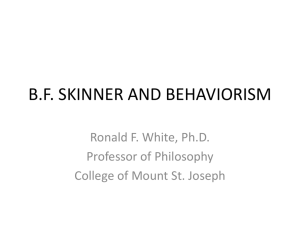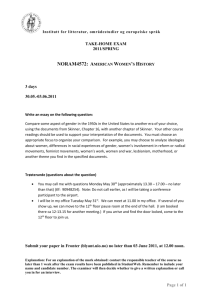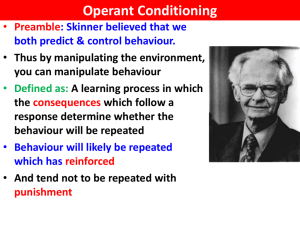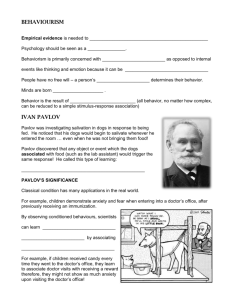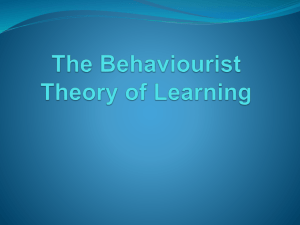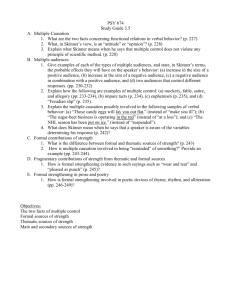File - E
advertisement
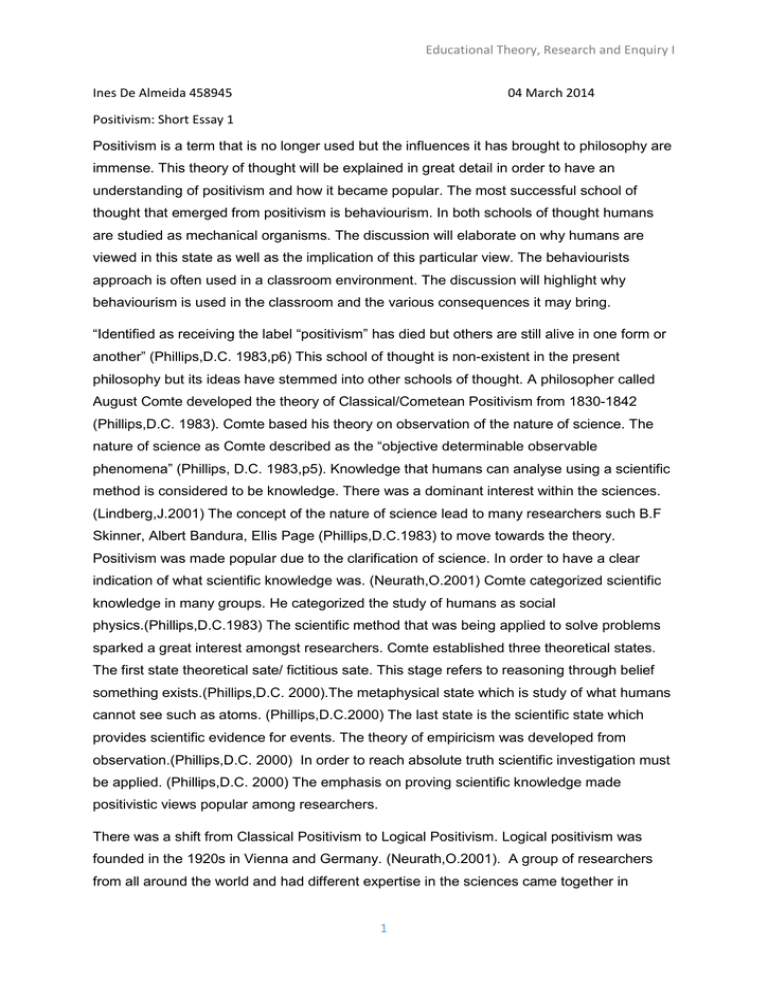
Educational Theory, Research and Enquiry I Ines De Almeida 458945 04 March 2014 Positivism: Short Essay 1 Positivism is a term that is no longer used but the influences it has brought to philosophy are immense. This theory of thought will be explained in great detail in order to have an understanding of positivism and how it became popular. The most successful school of thought that emerged from positivism is behaviourism. In both schools of thought humans are studied as mechanical organisms. The discussion will elaborate on why humans are viewed in this state as well as the implication of this particular view. The behaviourists approach is often used in a classroom environment. The discussion will highlight why behaviourism is used in the classroom and the various consequences it may bring. “Identified as receiving the label “positivism” has died but others are still alive in one form or another” (Phillips,D.C. 1983,p6) This school of thought is non-existent in the present philosophy but its ideas have stemmed into other schools of thought. A philosopher called August Comte developed the theory of Classical/Cometean Positivism from 1830-1842 (Phillips,D.C. 1983). Comte based his theory on observation of the nature of science. The nature of science as Comte described as the “objective determinable observable phenomena” (Phillips, D.C. 1983,p5). Knowledge that humans can analyse using a scientific method is considered to be knowledge. There was a dominant interest within the sciences. (Lindberg,J.2001) The concept of the nature of science lead to many researchers such B.F Skinner, Albert Bandura, Ellis Page (Phillips,D.C.1983) to move towards the theory. Positivism was made popular due to the clarification of science. In order to have a clear indication of what scientific knowledge was. (Neurath,O.2001) Comte categorized scientific knowledge in many groups. He categorized the study of humans as social physics.(Phillips,D.C.1983) The scientific method that was being applied to solve problems sparked a great interest amongst researchers. Comte established three theoretical states. The first state theoretical sate/ fictitious sate. This stage refers to reasoning through belief something exists.(Phillips,D.C. 2000).The metaphysical state which is study of what humans cannot see such as atoms. (Phillips,D.C.2000) The last state is the scientific state which provides scientific evidence for events. The theory of empiricism was developed from observation.(Phillips,D.C. 2000) In order to reach absolute truth scientific investigation must be applied. (Phillips,D.C. 2000) The emphasis on proving scientific knowledge made positivistic views popular among researchers. There was a shift from Classical Positivism to Logical Positivism. Logical positivism was founded in the 1920s in Vienna and Germany. (Neurath,O.2001). A group of researchers from all around the world and had different expertise in the sciences came together in 1 Educational Theory, Research and Enquiry I Vienna to form the Vienna Circle (Phillips, D.C, 1983). These researches consisted of Schlick, Frank, Carnap, Waissman, Neurath, Godel, Hahn, Kraft and later Reichenbach, Hempel, Ayer (Phillips,D.C.2000) Logical positivism influenced the ideas of liberalism in the late 19th century and Marxism. (Neurath,O.2001) Logical positivist rejected the notion of metaphysics unlike the classical positivists. Metaphysics could not be observed. Popper stated that metaphysics was important because scientific ideas stemmed from metaphysics but it did not pertain to science (Phillips,D.C. 2000). This is contradictory because logical positivist believed science could make improve society in the future which was one of its main attractions. (Phillips,D.C.1986) The emphasis on proving scientific knowledge made positivistic views popular among researchers. Logical positivists believed in the Verifiability Principle which Classical Positivist did not. (Phillips, D.C. 1983) This made it easier for philosophers to distinguish what was science and what was not. The Verifiability Principle was based on “If it can’t be seen or measured, it is not meaningful to talk about” (Phillips, D.C, 1983). This brought more interest in the theory because there were guidelines to what should be considered as knowledge. The Verifiability Principle eventually was discredited due to many critics in philosophy (Phillips, D.C.1983). The fall of positivism was due to the assentation of the philosopher Schlick and the rise of Adolf Hitler which in the 1930s. (Phillips, D.C. 1983). Positivism had a great influence on behaviourism. “Man continues to be described as though he were some complicated piece of machinery” (Heather,H.1979, p87). Behaviourists and Positivists view human nature to be objective. There is an input and a desirable output just like machines. Man has no agency and is seen as predictable. (Heather,H. 1979) Heather explains it is because human behaviour is categorized as scientific physics which is completely objective. Behaviourists only deduct on what is observable which results in predicting and controlling behaviour. (Heather,H. 1979). According to Skinner the arrangement of contingencies can result into the desirable behaviour. These are future events or schedules that enable us to predict behaviour. Skinner relies on three factors that produce desirable behaviour. We learn by doing and we learn from experience. The learner is seen as taking an active role within the learning environment. (Skinner, B.F. 1968) Experience is seen as the input for the behaviour and doing is seen as the output. This is another example of how Skinner views human behaviour in a mechanical form. (Skinner, B.F. 1968) We are able to devise thinking patterns that happen within the learner that result in the desirable behaviour. The third factor is we learn by trial and error. This relates to the consequences of the behaviour for example punishment and reward (Skinner, B.F.1968). This is another reference to how humans are seen as mechanical. There is no agency but 2 Educational Theory, Research and Enquiry I there is simply reward and punishment. This is referred to as positive and negative reinforcement. Skinner calls this operate conditioning. (Skinner, B.F. 1968) These responses are a display natural behaviour in organisms. Any behaviour that is not predicted or out of the norm is merely seen as a contingency. This view disregards human intuition, feeling or reasoning which gives the perception of humans being ‘well- oiled machines’. “Different performances can be brought under the control of different stimuli in the same organism” (Skinner, B.F. 1968, p45).The statement shows that it does not matter what organism it is whether it be rats, pigeons or humans there will be a similar behaviour responses. (Skinner,B.F.1986) The researcher must be aware of what the desirable behaviour is and what reinforcements can be in order to evoke the behaviour. (Skinner,B.F.1986) Humans are seen merely as a ‘thing’ with no type agency. (Heather,H.1979). Humans are being demoted in a sense, because they are seen put in a class with other organisms that are not at the same complexity as a human. (Heather,H.1979) The behaviourist approach has been applied in the classroom and it reflects how learners are being seen as mechanical beings. In foundation phase mathematics, the child is expected to have a large number of responses (Skinner,B.F. 1968). The teachers goal is get the learners to write, or verbally say the right number whether they are doing subtraction, addition, division or multiplication (Skinner,B.F. 1968). The behaviour must be in control of the stimulus. In order to control behaviour positive and negative reinforcement is used (Skinner,B.F.1986). For example a learner is sitting at his desk working on a worksheet. This behaviour is adhered to because the learner does not want the teacher to give him a demerit. Another teacher may use positive reinforcement by given a learner a star when he is finished with his work. Humans cannot be seen merely as mechanical organisms because our internal environment needs to be considered. “If a man is free, there is no way of predicting what he will do and therefore no chance of describing his behaviour in lawful terms” (Heather,H.1976,p22). The behaviour cannot be predicted because humans interpret the world around them due to intuition and agency. Skinner’s “stimulus” and “reinforcements” may be interpreted differently by each individual and therefore we cannot predict how a human will react to it (Heather,H.1976). Therefore there is no predicted input or output and the view of mechanical beings is rejected. Since we cannot observe our internal environment it does not mean it must be disregarded. (Heather,H.1976) A human’s internal environment must be considered because it has an influence on our behaviour. (Heather,H.1976) Behaviour cannot be seen purely as an individual experience. (Heather,H.1976) The social environment also plays a 3 Educational Theory, Research and Enquiry I role, interactions between individuals allow for shared experiences and meanings. These meanings are constructed from these interactions and influence human behaviour. (Heather,H.1976) . This is why behaviourist could not explain the learning of language(Heather,H.1976) “Education is perhaps the most important branch of scientific technology” (Skinner,B.F.1968,p19) Skinner stresses that education is part of science and is important because it manufactures desirable behaviour. Problems were raised in the traditional education system pertaining to behaviourism (Skinner, B.F,1968). There were infrequencies of reinforcement. The learners are dependent on the teacher to tell them if they are right or wrong. (Skinner,B.F.1968) Reinforcements should be given in less than 24 hours to the learners in order for the desirable behaviour to occur.(Skinner,B.F.1968) In cases such as tests the learner will receive feedback a day or so later. The teacher is not able to effectively reinforce learners because of the number of learners in a class. Learning is more focused on external factors such as democracy and not reinforcements which has an effect on behaviour.(Skinner,B.F.1968). In order to eradicate these problems in the classroom Skinner developed machines which would help learners with mathematics and spelling. “She must have help of mechanical devices” (Skinner,B.F.1968,p22) These machines provided immediate reinforcement and was not dependent on the teacher. These machines offered continuous revision and no aversive control. (Skinner,B.F.1968). The machines were introduced to replace the role of the teacher. “The teacher is out of date” (Skinner,B.F.1968,p22). This emphasises that teachers were not seen as humans but were seen as a means for an outcome. Teachers can be replaced with a machine so primarily they were seen as machines. The behaviourist approach in a classroom can be problematic. Teachers will be expect certain answers from a learner. Once the teacher has gotten the right answer she will move on to the next phase of work. Learners are not given the opportunity to question and critically analyse content. This may cause learners to not understand the foundation of the content but simply just know the right answer. Teachers may not expect the learner to ask why? The teacher may not be able to scaffold content knowledge because she is simply looking for the right answer. Skinners machines were designed to give the right and wrong answers which will not solve the problem either. Social interactions are important in order to produce critical learners. A learner has agency and the social interactions create meanings and foundations for content knowledge (Heather,H.1968) Social meanings may influence his/her behaviour.(Heather,H.1968) 4 Educational Theory, Research and Enquiry I Positivism has had a great influence on the philosophical and psychological fields. The clarity of the sciences came to great use. The theory has many discrepancies and inconsistent statements. Such as the categorization and meaning of metaphysics. (Heather,H.1968) Positivism influenced behaviourism due to the objective views of positivists. Behaviourists viewed humans as mechanical which is not the case due to the fact agency, consciousness and intuition of humans need to be considered as some of the influences of behaviour. Adapting behaviourism in the classroom will produce learners that are not able to reason and critically think of the world around them. These learners will simply be products of a ‘well-oiled machine’ 5 Educational Theory, Research and Enquiry I Reference List Heather,H.(1979). Positivism and psychology. Radical Perspectives in Psychology. London: Methuen. 2,11-39 Neurath, O.(2001).Physicalism. In Lindberg,J.J.(Eds). Analytical philosophy: Beginnings to the present. Mayfield CA: Mayfeild Publishing Company. Phillips, D.C. (2000). Positivism. The expanded social scientists bestiary. Lanham: Rowman & Littlefield. 9,156-168 Phillips, D.C.(1983). After the wake: postpositivistic educational thought. Educational Researcher, 12(5), 4-12 Skinner, B.F. (1968). The etymology of teaching. The technology of teaching. Englewood Cliffs: Prentice Hall. 1,1-8 Skinner, B.F. (1968). The science of learning and the art of teaching. The technology of teaching. Engelwood Cliffs: Prentice Hall. 2, 9-28 6
